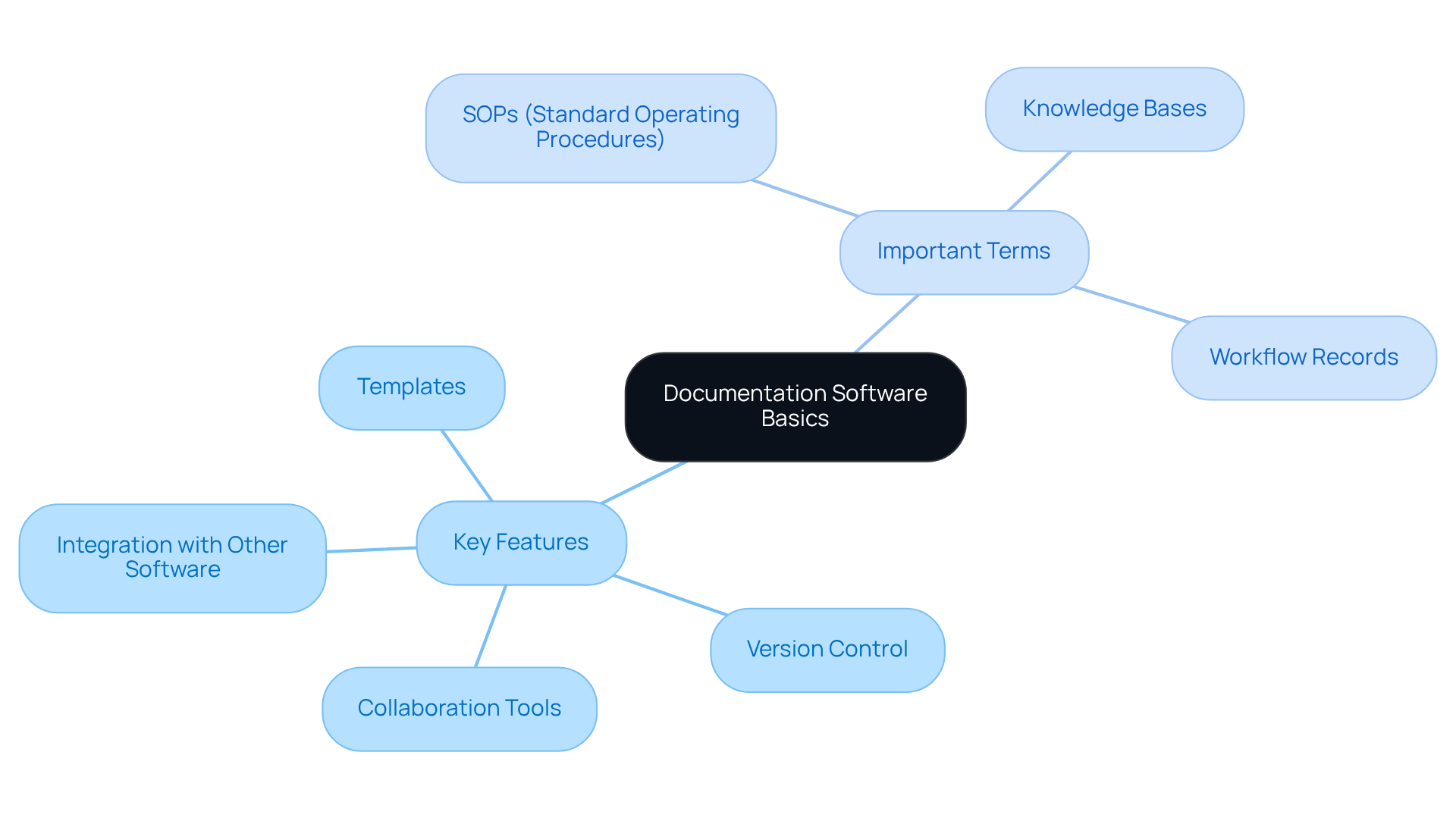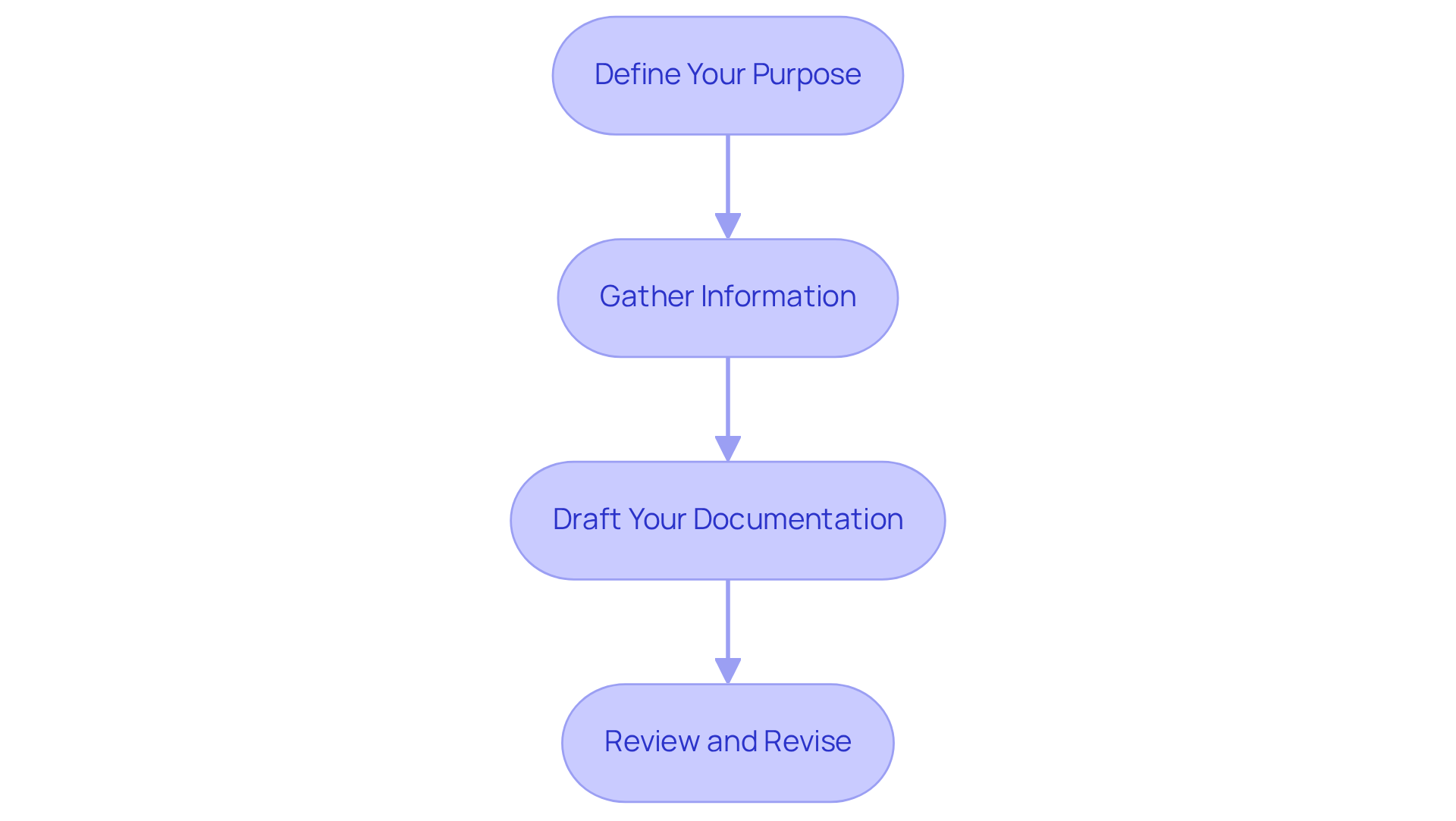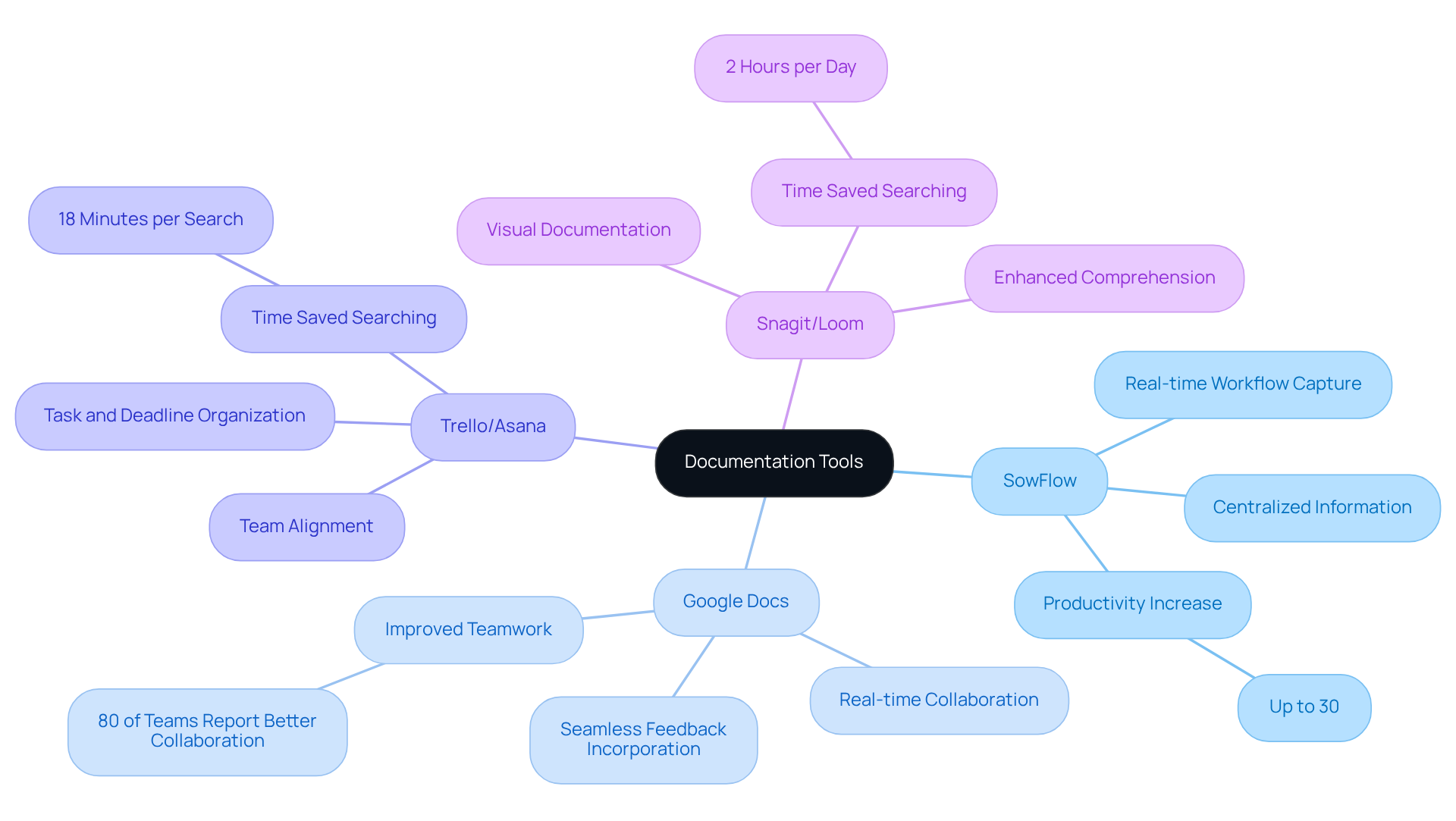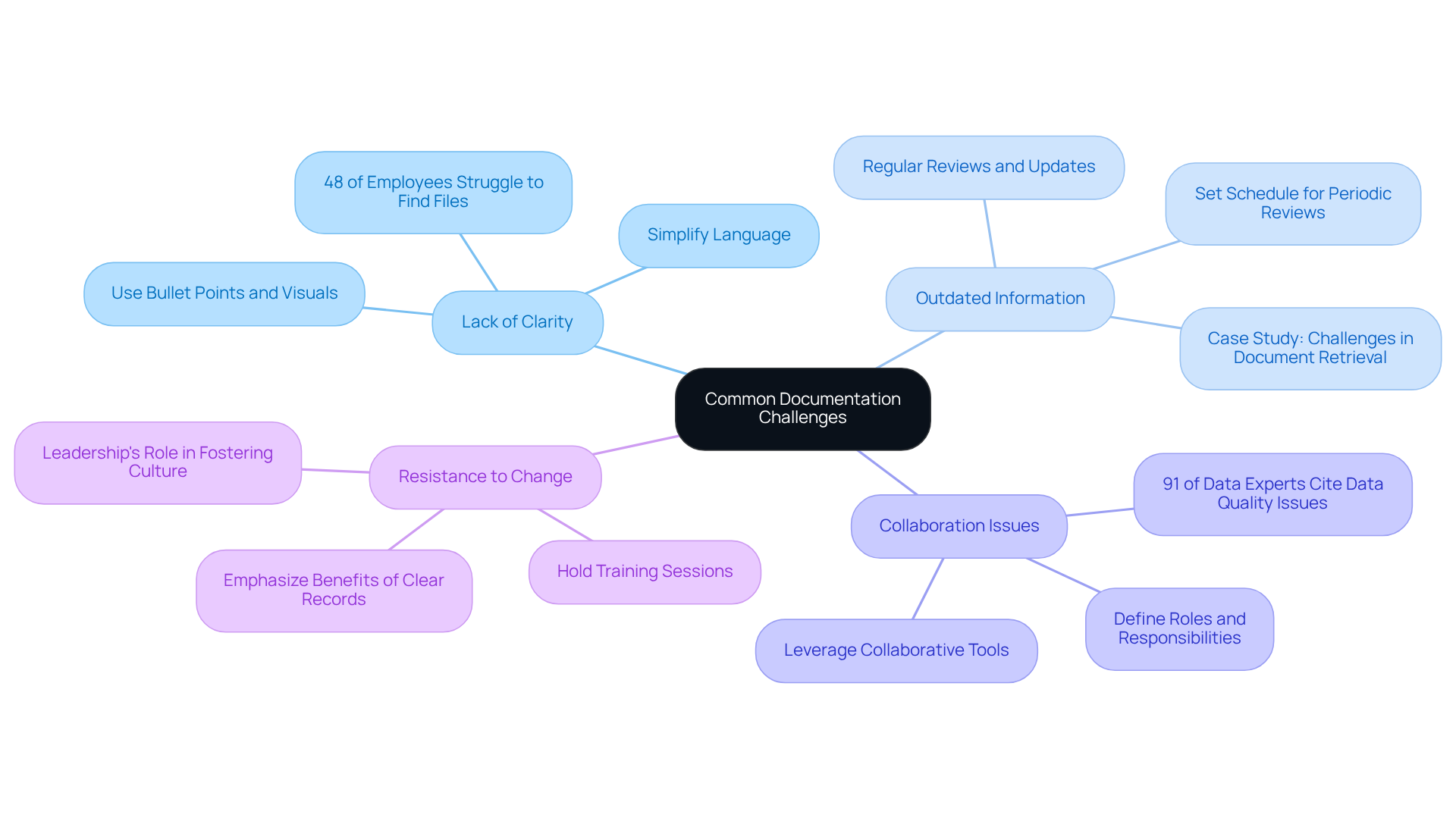
Knowledge Management through Documentation
|
October 17, 2025
|
4 Steps to Create Documentation Software Effectively
Overview
You might be wondering how to create documentation software that really works. Well, the article breaks it down into four essential steps:
- Defining the purpose
- Gathering information
- Drafting
- Reviewing or revising
By following these steps and using collaborative tools, you can tackle common challenges and boost productivity and knowledge management in your organization.
Now, let’s dive into why these steps matter. Think about it: without a clear purpose, your documentation can become a jumbled mess. Gathering the right information ensures you’re not missing any crucial details. Drafting is where the magic happens, and reviewing or revising? That's your chance to polish everything up. So, how can you make this process smoother? By addressing these steps, you’ll not only enhance your documentation but also foster a culture of collaboration and efficiency.
So, are you ready to take your documentation to the next level? Remember, it’s all about making these steps work for you and your team. With a little effort, you’ll find that effective documentation can really transform the way your organization shares knowledge.
Key Highlights:
- Documentation software helps organisations generate, organise, and store records effectively.
- Key features of documentation software include templates, version control, collaboration tools, and integration capabilities.
- Important terms to understand include Standard Operating Procedures (SOPs), knowledge bases, and workflow records.
- The documentation creation process involves defining purpose, gathering information, drafting, and reviewing/revising.
- Efficient information gathering can save time, as knowledge workers spend significant hours searching for information.
- Tools like SowFlow, Google Docs, Trello, Asana, Snagit, and Loom enhance documentation efficiency and collaboration.
- Common documentation challenges include lack of clarity, outdated information, collaboration issues, and resistance to change.
- Improving documentation processes can lead to enhanced productivity and better knowledge management.
Introduction
Creating effective documentation software is super important in today’s fast-paced business world. You might be wondering how clear records can really boost your organization’s efficiency. Well, this guide is here to walk you through the essential steps and tools you’ll need to develop documentation software that not only hits the mark but also enhances collaboration and productivity. But wait, with challenges like outdated info and clarity issues creeping in, how can you make sure your documentation stays relevant and user-friendly? Let’s dive into this together!
Understand Documentation Software Basics
You might be wondering how to create documentation software that ensures your organization's records are organized and efficient. Well, these tools are designed just for that! They help you generate, organize, and store your records effectively. You’ll find key features like:
- Templates
- Version control
- Collaboration tools
- The ability to integrate with other software
Understanding these basics can really help you pick the right software for your needs and make the most out of it.
Now, let’s dive into some important terms you should get familiar with, like 'SOPs' (Standard Operating Procedures), 'knowledge bases', and 'workflow records'. These are going to be essential as you work to create documentation software for your efforts. So, get ready to explore and enhance your writing skills!

Follow Step-by-Step Instructions for Documentation Creation
- Define Your Purpose: You might be wondering where to start with your records. It’s all about clarifying your specific aim. Are you crafting guides, standard operating procedures (SOPs), or maybe some training materials? Understanding your audience and goals is key here; it shapes the content and structure of the documentation software you create. With SowFlow, you can easily whip up user guides that align perfectly with your objectives, making sure your materials hit the mark.
- Gather Information: Next up, let’s talk about gathering information. This is where you collect all the essential details related to the processes or topics you’re documenting. You might find yourself interviewing team members, digging through existing documents, or even observing workflows. Did you know that knowledge workers spend around 2.5 hours a day just searching for information? That’s why efficient information gathering is crucial. With SowFlow’s instant record-keeping solution, you can access your files with a single command, cutting down on all that time spent hunting for answers.
- Draft Your Documentation: Now that you’ve got your information, it’s time to draft your documentation. Use clear headings, bullet points, and visuals to make it easy to read. Keep your language simple and direct so everyone can grasp the content without a hitch. SowFlow makes it easy to create documentation software for user guides, boosting productivity by reducing the time employees waste on unclear processes.
- Review and Revise: Once you’ve wrapped up your draft, it’s review time! Get some feedback from stakeholders or colleagues and make any necessary revisions to ensure everything is accurate and clear. Operations managers have found that a well-organized record-keeping process not only saves time but also fosters a culture of teamwork and efficiency. Plus, treating your records like a 'living document' is super important to keep them relevant in our fast-paced business world. With SowFlow, updating and enhancing your records is a snap, so they stay fresh and effective.

Utilize Tools and Resources for Efficient Documentation
To create documentation software efficiently, you might be wondering what tools can help. Let’s dive into a few options that could really make a difference:
- SowFlow: This intuitive documentation tool lets you capture workflows directly from your browser. Imagine documenting processes in real-time! By centralizing information, SowFlow cuts down on those time-consuming meetings and boosts productivity. In fact, research shows that organizations using management systems for files can see productivity increases of up to 30%.
- Google Docs: A powerful collaborative platform, Google Docs allows multiple users to edit and comment on documents at the same time. This real-time collaboration means feedback is seamlessly incorporated, enhancing the overall quality of your records. According to GitHub, "Documentation enhances collaboration, with 80% of groups indicating improved cooperation." Many users rave about how Google Docs simplifies the writing process and improves collaboration.
- Trello or Asana: Ever find yourself scrambling to keep track of tasks and deadlines? Tools like Trello and Asana can help you organize everything effectively, ensuring that all team members are on the same page. This kind of organization can prevent the common headache of employees spending around 18 minutes per search looking for needed files.
- Snagit or Loom: Tools like Snagit and Loom allow you to capture screenshots or record videos, adding a visual element to your documentation. This is super important because studies show that materials with visuals can really enhance comprehension and retention. Plus, documentation that includes visuals can significantly cut down on the time wasted searching for documents. Did you know that, according to Glean.com, Americans spend an average of two hours a day searching for documents? That’s a lot of lost time!
So, which tool will you try first to make your documentation process smoother? Making the right choice can help you create documentation software that saves you a ton of time and effort!

Troubleshoot Common Documentation Challenges
You might be wondering about some common challenges that arise when you create documentation software effectively. Let's dive into a few key issues that can really impact your team's productivity.
- Lack of Clarity: Unclear documentation can really throw a wrench in the works, can't it? To boost clarity, take a moment to revisit your drafts and simplify the language. Bullet points and visuals can work wonders to break down complex info, making it easier for users to digest. Did you know that 48% of employees struggle to find files quickly? That really underscores the need for clear records!
- Outdated Information: Keeping your records fresh is super important. Regularly reviewing and updating materials helps ensure they stay relevant. Setting a schedule for periodic reviews and reminders can make this practice a breeze. A case study on "Challenges in Document Retrieval" shows just how much confusion outdated documents can cause and highlights the perks of using a cloud-based document management system.
- Collaboration Issues: Effective collaboration is key to thorough record-keeping. It’s essential to clearly define roles and responsibilities for record-keeping tasks within your team. Plus, leveraging collaborative tools can really help facilitate communication and ensure everyone is on the same page. As Mark Fairlie points out, 91% of data experts say that data quality issues can negatively impact company performance. That really emphasizes the importance of teamwork in keeping accurate records!
- Resistance to Change: Creating a culture of records is vital for success. It’s all about emphasizing the benefits of maintaining clear and current records to your team. Consider holding training sessions to help everyone understand the procedures and encourage them to adopt these practices. Remember, leadership plays a crucial role in fostering a culture of effective record-keeping.
By tackling these challenges head-on, organizations can significantly enhance their processes to create documentation software, leading to improved productivity and better knowledge management. So, what steps will you take to address these challenges in your own documentation efforts?

Conclusion
Creating effective documentation software is super important for any organization looking to boost its record-keeping and operational efficiency. You might be wondering how to tackle this. By understanding the basics of documentation software, following a clear plan, and using the right tools, organizations can really step up their documentation game and overall productivity.
So, what’s the game plan? This article lays out a simple four-step guide:
- Define the purpose of your documentation
- Gather the relevant information
- Draft clear and concise content
- Review and revise the final product
And don’t forget about the tools! Using platforms like SowFlow, Google Docs, Trello, and visual aids can help streamline the process and tackle common hiccups like unclear information, outdated content, collaboration issues, and resistance to change.
Now, let’s wrap this up! Investing time and effort into creating effective documentation software not only saves you time but also builds a culture of clarity and collaboration within your teams. By embracing best practices and leveraging the right tools, organizations can overcome documentation challenges and keep accurate, up-to-date records that enhance productivity and knowledge management. Taking these steps will ensure that documentation becomes a valuable asset rather than a burdensome task, ultimately driving success and efficiency in the workplace.
Frequently Asked Questions
What is the purpose of documentation software?
Documentation software is designed to help organizations generate, organize, and store their records effectively.
What are some key features of documentation software?
Key features include templates, version control, collaboration tools, and the ability to integrate with other software.
Why is it important to understand the basics of documentation software?
Understanding the basics can help you choose the right software for your needs and maximize its effectiveness.
What are some important terms to know when creating documentation software?
Important terms include 'SOPs' (Standard Operating Procedures), 'knowledge bases', and 'workflow records'.
How can familiarizing oneself with documentation software terms benefit users?
Familiarity with these terms is essential for effectively creating and utilizing documentation software in your efforts.
👍
What others are liking
5 Steps to outline your ideal documentation structure
5 MINS READ
Where to start the your journey of mapping out your ideal documentation structure, aligning it with the very heartbeat of your organization?
Defining a winning level of detail in your process
3 MINS READ
What is too much detail, and what is too little? This article described in that winning level detail about what detail is enough.





